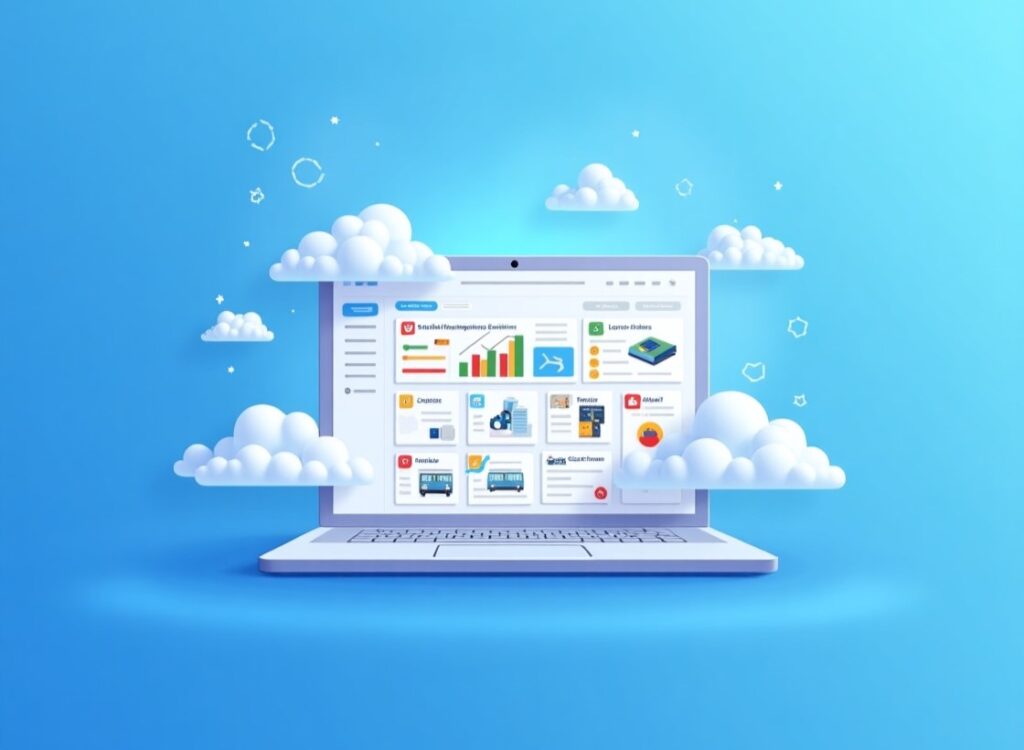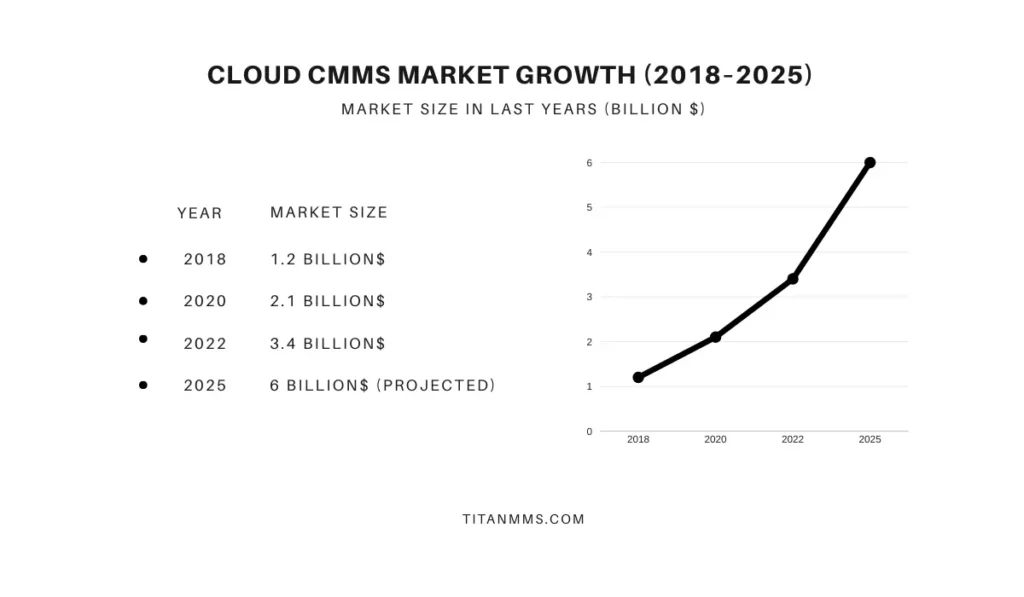Introduction
Cloud CMMS software (cloud based CMMS) is transforming maintenance operations by allowing teams to manage assets, schedule work orders, and monitor performance from anywhere. Unlike traditional on-premise systems, a cloud based maintenance management software frees you from heavy infrastructure, delivers faster updates, and scales with your business. If you’re evaluating cloud CMMS or cloud based maintenance software, this blog walks you through key benefits, features to look for, and how to choose the right solution.

What is a Cloud Based CMMS?
A Cloud-Based CMMS is a maintenance management solution hosted online, giving teams access anytime, anywhere. A software solution that helps organizations manage their maintenance operations more efficiently by leveraging cloud technology. Unlike traditional CMMS, which are installed locally on company servers, cloud-based CMMS operates over the internet. This means you can access it from anywhere, at any time, using web browsers and mobile apps and any device with internet connectivity.
Learn about: Web Based CMMS Software
Key Features of Cloud-Based CMMS
- Centralized asset and work order management.
- Preventive & predictive maintenance scheduling.
- Mobile-friendly access for field teams.
- Real-time reporting and dashboards.
- Lower upfront cost compared to on-premise CMMS.
- Automatic updates are the latest features and security updates without manual intervention.
Why Cloud-Based Maintenance Software is Essential
| Benefit | Cloud CMMS | Traditional CMMS |
|---|---|---|
| Accessibility | 24/7, Anywhere | Limited to office PCs |
| Cost | Subscription-based | Heavy upfront investment |
| Scalability | Easy to scale | Requires hardware upgrades |
| Updates & Security | Automatic | Manual updates, vulnerable |
| Mobile Support | Native apps | Rarely mobile-friendly |
| Data Insights | Real-time dashboards | Delayed reports |
Learn about: CMMS vs Traditional Maintenance.
Benefits of Cloud Based CMMS Software
- Accessibility – Access your CMMS anytime, anywhere with just an internet connection for remote maintenance management.
- Cost – Save on upfront hardware and IT costs with an affordable subscription-based cloud CMMS model.
- Scalability – Easily expand to support more users, assets, and locations as your business grows.
- Updates & Security – Get automatic updates, enhanced data protection, and compliance without downtime.
- Mobile Support – Use mobile apps to receive work orders, update tasks, and manage assets on the go.
- Data Insights – Gain real-time analytics to optimize resources, prevent downtime, and improve decision-making.
Cloud CMMS Market Growth & Adoption
According to industry reports, cloud-based maintenance management software adoption has grown rapidly as companies move away from legacy systems.
Chart: Cloud CMMS Market Growth (2018–2025)

Cloud CMMS vs. On-Premise: Which is Better?
Comparison Chart
Cloud-Based CMMS Software
✅ Lower setup cost
✅ Access from any device
✅ Automatic updates
✅ Easier collaboration
On-Premise CMMS
❌ High setup & maintenance cost
❌ Limited access (local servers only)
❌ Requires IT support
❌ Less flexibility
Enhancing Maintenance Operations
Streamlining Work Orders
Creating, assigning, and tracking work orders becomes seamless with cloud-based CMMS. Technicians can receive alerts and updates in real-time, ensuring that no task falls through the cracks.
Preventive Maintenance Scheduling
Preventive maintenance is essential to avoid unexpected equipment failures. Cloud-based CMMS can automatically schedule and remind teams of upcoming maintenance tasks, significantly reducing the risk of unplanned downtime.
Asset Management
Keeping track of all assets, their conditions, and maintenance history is simplified. This ensures that each piece of equipment gets the attention it needs to operate efficiently.
Inventory Control
Efficiently managing spare parts and supplies ensures that necessary items are always in stock, reducing delays and avoiding overstocking.
Improving Efficiency and Productivity
Real-Time Data and Analytics
Access to real-time data allows for more informed decision-making. Analytics can identify trends and potential issues before they escalate, enabling proactive maintenance.
Improved Communication and Collaboration
With all information centralized and accessible, communication between team members and departments improves. Collaborative features in cloud-based CMMS facilitate better coordination and information sharing.
Reduced Downtime
By predicting and preventing potential failures, cloud-based CMMS minimizes downtime, keeping operations running smoothly and efficiently.
Cost Savings and ROI
Lower Initial Investment
Cloud-based solutions eliminate the need for expensive hardware and software purchases. The subscription model allows for predictable and manageable expenses.
Reduction in Maintenance Costs
Proactive maintenance and efficient resource management lead to fewer breakdowns and repairs, lowering overall maintenance costs.
Long-Term Financial Benefits
Over time, the efficiency gains and cost savings from a cloud-based CMMS translate into a significant return on investment (ROI).
Learn about: Benefits and ROI of Implementing CMMS.
Case Studies and Real-World Examples
Many companies across various industries have successfully implemented cloud-based CMMS solutions, seeing significant improvements in their maintenance operations. For instance, a manufacturing company might report a 20% reduction in downtime, while a healthcare facility could see enhanced compliance with regulatory standards.
Use Cases of Cloud CMMS
- Manufacturing – Predictive maintenance reduces downtime
- Facilities Management – Centralized work orders & scheduling
- Healthcare – Compliance & asset reliability
- Logistics – Real-time equipment tracking
- Utilities – Mobile maintenance for field technicians
Integration with Other Systems
Compatibility with ERP and IoT
A major advantage of cloud-based CMMS is its ability to integrate seamlessly with other systems like Enterprise Resource Planning (ERP) and Internet of Things (IoT) devices. This integration provides a more comprehensive view of operations, enhancing decision-making and operational efficiency.
Security and Reliability
Data Protection Measures
Cloud-based CMMS software ensures data security with end-to-end encryption, regular backups, multi-factor authentication, and strict access controls, providing businesses with confidence in their data protection.
System Reliability
With robust cloud infrastructure, redundancy, and uptime guarantees, cloud CMMS solutions provide high availability—keeping maintenance operations running without interruption.
Customization and Flexibility
Tailored to Industry Needs
Cloud CMMS can be customized for industries like manufacturing, healthcare, facilities, and utilities, adapting workflows, features, and reporting.
Adapting to Business Growth
Unlike traditional systems, cloud-based maintenance software scales easily as requirements change, supporting new locations, assets, and users.
User-Friendly Interface
- Ease of Use & Training – Simple dashboards and intuitive navigation reduce learning curves and speed up employee onboarding.
- Higher Adoption Rates – Mobile-first design and accessibility encourage staff adoption, ensuring full system utilization.
Environmental Impact
- Sustainable Maintenance – Optimized schedules reduce unnecessary servicing and extend asset life.
- Lower Waste & Energy Use – Cloud CMMS helps organizations cut waste and energy consumption, supporting green initiatives.
Challenges and Considerations
- Potential Drawbacks – Internet dependency and data privacy concerns may be challenges for some organizations.
- Implementation Tips – Involve key stakeholders, create a clear rollout plan, and provide ongoing training & support for success.
Future Trends in Cloud CMMS
Next Decade Outlook – Cloud-based CMMS software will become more integrated, intelligent, and essential for asset management across industries.
Emerging Technologies – AI, ML, IoT, and AR will power predictive maintenance, smart analytics, and real-time diagnostics.
Conclusion
Cloud based CMMS software is transforming maintenance operations by offering enhanced efficiency, cost savings, and flexibility. By leveraging the power of the cloud, businesses can streamline their maintenance processes, improve asset management, and achieve significant long-term benefits. Embracing this technology is a strategic move towards more efficient, reliable, and sustainable maintenance operations.
Learn How to Train Your Team for Effective CMMS Use.
The CMMS market is booming—projected to grow from $1.3 billion in 2024 to $2.4 billion by 2030, at 11.1% CAGR (Grand View Research). Studies show businesses using CMMS cut maintenance costs by up to 25% and reduce failures by 30% (U.S. Department of Energy). With governments and industries promoting digital asset management, Titan CMMS helps companies boost efficiency, minimize downtime, and save money.
FAQs
Ans. The primary advantage is accessibility. Cloud-based CMMS can be accessed from anywhere with an internet connection, providing greater flexibility and mobility compared to traditional, on-premise CMMS
Ans. It helps by streamlining maintenance processes, enabling preventive maintenance, improving inventory control, and reducing downtime, all of which contribute to lower overall maintenance costs.
Ans. Yes, they typically offer robust security measures, including data encryption, regular backups, and stringent access controls to protect sensitive information.
Ans. Absolutely. Cloud-based CMMS solutions can integrate with ERP systems, IoT devices, and other business applications to provide a comprehensive view of operations and enhance overall efficiency
Ans. Future trends include the integration of AI, ML, and AR to offer predictive maintenance, advanced diagnostics, and more intuitive user experiences, making maintenance operations even more efficient and proactive.
Maximize Your Maintenance Efficiency with Titan CMMS
Titan CMMS has the proven expertise to help your organization adopt smart maintenance practices and implement safe, scalable CMMS solutions. Reach out to schedule a risk-free consultation with our maintenance management experts.
